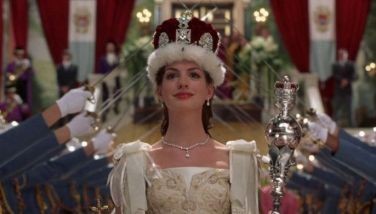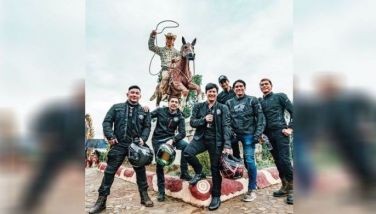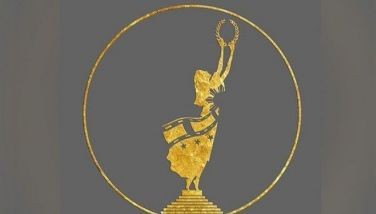A Bacolod museum goes Christmas
MANILA, Philippines - As a bright star — more like a guiding light and a formidable force — led some shepherds from nearby fields and three Magi from faraway lands to a Babe in a manger some 2,000 years ago in a sleepy town in Bethlehem — a huge, colorful parol with rotating blinking lights on a façade of a neo-classical house, caught the attention of my travel buddies, my sister Honey Jarque-Loop and Freddie Alquiros while on a recent trip to the city of Bacolod.
Though we just had happily survived a comprehensive, yet exhausting tour of some awesome ancestral homes in the cities of Silay and Talisay graciously hosted by lawyer Helen Catalbas of the Department of Tourism (DOT) Western Visayas Region, we, together with our tour escort DOT’s Ray Tabafunda, quickly alighted from the van to satisfy our curiosity. How little did we know then, that we were soon to discover a pocket museum, which at this particular time of the year, had completely transformed itself to everything that is Christmas with success.
Usually on most days, the several decades-old home of the close-knit family of Raymundo Dizon and his wife, the former Hermelinda Ramos, endearingly showcases glimpses of the area’s upper-middle class lifestyle of the ’50s with their only-worthy-to-preserve antiques, classical memorabilia and flashback artifacts to include old collections of paintings and portraits, furniture and fixture, silver and china vajillas y bandejados and even porcelain angels and dolls.
In other parts of the two-storey stand-alone house are an educational diorama of Bacolod of yore, an eye-catching selection of award-winning masks from past Masskara festivals, heartwarming gallery on the Holy Land, a notable number of crystal and glass from all over the world, a serious collection from a horse enthusiast and other whimsical paraphernalia such as hundreds of key chains.
But that’s not all.
It likewise serves as a popular venue for arts and cultural exhibits featuring the obra maestras of the city’s old masters who continue to inspire with their works the promising apprentices to find their places in the sun.
“However, come every July, the entire place undergoes a much-awaited makeover,” declared Raymond Alunan, the knowledgeable and amiable curator, as he welcomed us to the Dizon-Ramos Museum.
“Most of our displays and exhibits are carefully stored away. And then several boxes — always seem like mountains of boxes — arrive on schedule from storage,” he continued.
“The seemingly insurmountable work begins immediately. Every night from 7 to 11 p.m. — at times, way past midnight — we meticulously open each pack. Mind you, we do this in the evenings when the museum is closed, in order not to bother our daily visitors. Before the ‘ber’ months come to a full swing, Christmas is everywhere, in every single corner of this museum,” he said, smiling with pride.
The Bacolod-born and bred Alunan, a hotel and restaurant graduate from La Consolacion College and who has served for the past three years as the provincial tourism information officer of Negros Occidental, confided that all this was possible due to the vast and precious collections of Bella Rivas Galang — a true lover of the holiday season, who is an ardent Francophile and a devoted professor of Music and French, her other passions in life.
As a cherished Christmas carol that was a hit once-upon-a-time filled the air, we expected to be introduced, though admittedly in numbers, to the usual white bearded and mustached Santa Claus in a made-to-order-just-for-him red suit and red elf hat complete with a red sack full of gifts on a sleigh pulled by reindeers led by red-nosed Rudolf. But no! We were pleasantly greeted by a company of some 304 variants of the jolly old man from the North Pole. Santa came from different races and colors, in variable sizes and shapes, distinct attire of several national costumes.
Looking around, we easily spotted Santas at work, Santas at play, Santas as performing artists as he sang, made music with several music instruments and even a drummer boy. How could we have missed a chef Santa with a frying pan as he was pointed out, since we were distracted by flying Santas on parachutes and wind chimes, more Santas by the sun and over the moon and the stars, as he kept a watchful eye on children eagerly awaiting for their gifts.
It was a sheer case of Santas here, there and everywhere. It seemed like he’s a been-there-done-that personality. “God bless his soul,” we chorused in unison.
Our next stop was the very heart of the museum. Right at the center of it all as it always brings together the true meaning of Christmas — the oh-so-familiar Nativity scene of Mary, Joseph and the Baby Jesus, found in ornate cathedrals and appreciated chapels, in private mansions and humble nipa huts plus or minus the shepherds and the Three Kings and the token sheep, a cow or two and perhaps a horse or even a donkey.
We restfully laid our eyes to all kinds of crèches — Belens to you and me — made from beautiful capiz shells and imported porcelain, clay-based terracotta and vulnerable ceramics, hand-blown glass, hand-made crochet and paper mache, and even clusters of plasters of Paris in various configurations and unique poses from admirable antique to highly-stylized, classic Victorian, from an interesting, yet intriguing retablo to one confined in a close-open box, from American Indians to role-playing little angels.
Having just whispered all but a brief prayer, we continued to explore the diverse pieces in silence, when Alunan proudly pointed out a Filipiniana Belen.
“It is my sentimental favorite, for it is the only set wherein the Sagrada Familia wear barong tagalogs and baro’t saya,” he claimed.
“Each of the tres reyes is dressed respectively in a G-string representing Luzon, a camisa chino from the islands of Visayas, and a Muslim attire of a Datu from Mindanao,” he continued. To complete the rustic picture, there were local domesticated animals around the stable, namely a carabao and a pig, a dog and a rooster. All we could do by then was say, “Amen.”
At the end of the hall, we came upon a well-laid-out Christmas dinner table made of Narra from the early ’50s. We figured it could easily sit a dozen members of the family with their friends.
On sight were chinaware artistically crafted by guildsmen from Canonsburg of Pennsylvania in America and the silver cutlery from Rogers, known the world-over. The much-loved items were wedding gifts to the Dizons in 1937 and today remain part of the family heirloom.
The pièce de résistance of the entire museum at this time of the year, which fully occupies most of the entire ground floor with some 250 square meters in total area, is the most impressive, nothing-like-it Christmas Village we’ve ever seen. We must admit we simply gasped loudly like surprised children. We were utterly amazed and totally bewildered as we slowly recovered from absolute disbelief. To further heighten our seemingly we-can’t-take-it-anymore state, curator Alunan gamely revealed the litany of the inventory.
“Are you ready for this?” he warned us.
“Well, for starters we have 102 residences, 22 churches, 81 shops, seven public office buildings, 57 vehicles, carriages and sledges, 346 Christmas trees and five sets of forests distributed throughout the poblacion,” he said.
“Inhabited by over 400 men, women and children all bundled up in winter clothes pursuing a variety of activities within government centers and commercial establishments, residential areas and packets of leisure, the entire township includes a number of amusement parks with movable rides such as eight trains, five ferris wheels, five carousels, two merry-go-rounds, a couple on a boat ride and seven pairs on several skating rinks,“ he concluded.
Before we could react, he added as he pointed to a mini-Balay ni Tana Dicang, one of our favorite ancestral homes in the country. “It was made right here in Negros Occidental and it remains to be the only Filipiniana home in the Christmas Village, which incidentally is lighted by 412 electrical bulbs,” he said.
When we hesitantly asked why he painstakingly, yet religiously assembled the whole display almost single-handedly year after year, a broad wide smile instantly crossed curator Alunan’s face. “I enjoy immensely setting it all up and I certainly do it out of love for our museum for after all, isn’t Christmas about love?” he beamed.
We wholeheartedly agreed. We bade him farewell, firmly shook his hand and sincerely thanked him for an excellent job.
Merry Christmas!
(The Dizon-Ramos Museum Christmas Exhibit is open daily from 10 a.m. to 9 p.m. until Feb. 10, 2015. Entrance fees are: P40 for adults and P20 for children. For details, visit the museum’s Facebook account: [email protected] or call (34) 434-8512.)
- Latest
- Trending





























